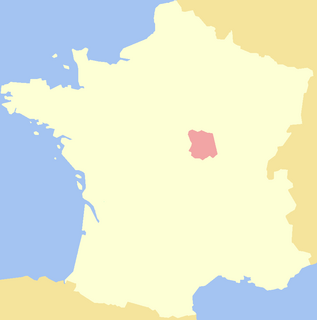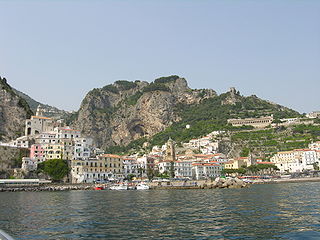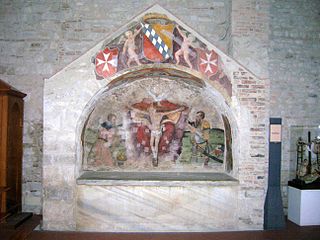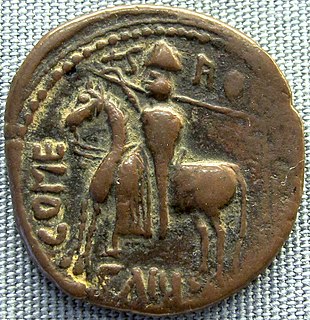Fulco of Basacers ( floruit 1083–1120) was an Italo-Norman knight and landholder with considerable possessions in the Val di Crati in Calabria. The seat of his lordship was "Brahalla", a place or castle that no longer exists. [1]
Floruit, abbreviated fl., Latin for "he/she flourished", denotes a date or period during which a person was known to have been alive or active. In English, the word may also be used as a noun indicating the time when someone flourished.
The Val di Crati was an administrative region in the Kingdom of Sicily. It was the territory originally conquered by Robert Guiscard in the 1050s. At that time, its population was a mix of Greek and Lombard (Latin) Christians. Under the Hohenstaufen and Angevin kings, the Val di Crati became closely associated with the terra iordanis, the land of Jordan, son of Roger I. The terra iordanis retained its distinct identity into the 13th century.
His first appearance in the historical record is in a Greek charter of 1083, where he is named Βαλσωχερεζ (Balsocherez). His name in Latin charters commonly appears as Fulco de Basagerio, but the identification of Basagerio remains elusive. It could be Bazoches in the Nivernais, but more probably he was from Normandy, perhaps Bazoches-au-Houlme or Bazoches-sur-Hoëne. [1] He was powerful enough to mint copper coins ( follari ) of his own, bearing the inscription FVLCVI DE BASACERS beneath a cross on one side, and two outward-facing busts with a cross between them and the letters RVC on the other. [2] The busts probably represent Fulco and his lord, Roger Borsa, who is probably referenced by RVC. Some of Fulco's coins are overstruck on Salernitan and Amalfitan coins known to date from the 1090s. [3] Probably these coins were minted with Roger's approval. It has been suggested that they were minted at Capua as late as 1134, after Fulco is recorded in that vicinity with Roger II, but such a late date is unlikely. Nor were the coins minted at Salerno, as once suggested. [1]

Greek is an independent branch of the Indo-European family of languages, native to Greece, Cyprus and other parts of the Eastern Mediterranean and the Black Sea. It has the longest documented history of any living Indo-European language, spanning more than 3000 years of written records. Its writing system has been the Greek alphabet for the major part of its history; other systems, such as Linear B and the Cypriot syllabary, were used previously. The alphabet arose from the Phoenician script and was in turn the basis of the Latin, Cyrillic, Armenian, Coptic, Gothic, and many other writing systems.

Bazoches is a commune in the Nièvre department in central France.

Nivernais is a former province of France, around the city of Nevers, which forms the modern department of Nièvre. It roughly coincides with the former Duchy of Nevers.

Lothair II or Lothair III, known as Lothair of Supplinburg, was Holy Roman Emperor from 1133 until his death. He was appointed Duke of Saxony in 1106 and elected King of Germany in 1125 before being crowned emperor in Rome. The son of the Saxon count Gebhard of Supplinburg, his reign was troubled by the constant intriguing of the Hohenstaufens, Duke Frederick II of Swabia and Duke Conrad of Franconia. He died while returning from a successful campaign against the Norman Kingdom of Sicily.

Amalfi is a town and comune in the province of Salerno, in the region of Campania, Italy, on the Gulf of Salerno. It lies at the mouth of a deep ravine, at the foot of Monte Cerreto, surrounded by dramatic cliffs and coastal scenery. The town of Amalfi was the capital of the maritime republic known as the Duchy of Amalfi, an important trading power in the Mediterranean between 839 and around 1200.

Roger III, of the House of Hauteville, was the eldest son and heir of King Tancred of Sicily and Queen Sibylla. He was made Duke of Apulia, probably in 1189, shortly after his father's accession. In the summer of 1192 he was crowned co-king with his father. Follari were minted at Messina bearing both Tancred and Roger's names as kings.

Sikelgaita was a Lombard princess, the daughter of Guaimar IV, Prince of Salerno, and second wife of Robert Guiscard, Duke of Apulia. She commanded troops in her own right.

The ducat was a gold or silver coin used as a trade coin in Europe from the later Middle Ages until as late as the 20th century. Many types of ducats had various metallic content and purchasing power throughout the period. The gold ducat of Venice gained wide international acceptance, like the medieval Byzantine hyperpyron and the Florentine florin, or the modern British Pound sterling and the United States dollar.

Roger Borsa was the Norman Duke of Apulia and Calabria and effective ruler of southern Italy from 1085 until his death. He was the son of Robert Guiscard, the conqueror of southern Italy and Sicily; Roger was not as adept as his father, and most of his reign was spent in feudal anarchy.

William I of Hauteville, known as William Iron Arm, was a Norman adventurer who was the founder of the fortunes of the Hauteville family. One of twelve sons of Tancred of Hauteville, he journeyed to the Mezzogiorno with his younger brother Drogo in the first half of the eleventh century (c.1035), in response to requests for help made by fellow Normans under Rainulf Drengot, count of Aversa.

The Duchy of Gaeta was an early medieval state centered on the coastal South Italian city of Gaeta. It began in the early ninth century as the local community began to grow autonomous as Byzantine power lagged in the Mediterranean and the peninsula due to Lombard and Saracen incursions.

The Duchy of Amalfi or the Republic of Amalfi was a de facto independent state centered on the Southern Italian city of Amalfi during the 10th and 11th centuries. The city and its territory were originally part of the larger ducatus Neapolitanus, governed by a patrician, but it extracted itself from Byzantine vassalage and first elected a duke in 958. During the 10th and 11th centuries Amalfi was estimated to have a population of 50,000 -70,000 people. It rose to become an economic powerhouse, a commercial center whose merchants dominated Mediterranean and Italian trade for centuries before being surpassed and superseded by the other maritime republics of the North, like Pisa, Venice, and Genoa. In 1073, Amalfi lost its independence, falling to French Norman invasion and subsequently to Pisa in 1137.
Guaimar III was the Lombard prince of Salerno from around 994 to his death. Under his reign, Salerno entered an era of great splendour. Opulenta Salernum was the inscription on his coins. He made Amalfi, Gaeta and Sorrento his vassals and annexed much of Byzantine Apulia and Calabria.

Alfonso, also called Anfuso or Anfusus, was the Prince of Capua from 1135 and Duke of Naples from 1139. He was an Italian-born Norman of the noble Hauteville family. After 1130, when his father Roger became King of Sicily, he was the third in line to the throne; second in line after the death of an older brother in 1138. He was the first Hauteville prince of Capua after his father conquered the principality from the rival Norman Drengot family. He was also the first Norman duke of Naples after the duchy fell vacant on the death of the last Greek duke. He also expanded his family's power northwards, claiming lands also claimed by the Papacy, although he was technically a vassal of the Pope for his principality of Capua.
John II was the duke of Amalfi from 1029 to 1069 with multiple interruptions. He was the son of Sergius II and Maria, sister of Pandulf IV of Capua. He was the last significant duke of Amalfi before the Norman conquest of 1073.
Manso II the Blind was the duke of Amalfi on three separate occasions: from 1028 to 1029, from 1034 to 1038, and from 1043 to 1052. He was the second son of Sergius II and Maria, sister of Pandulf IV of Capua. His whole ducal career consisted of wars with his brother, John II, over the throne. The Chronicon Amalfitanum is an important source for his reign.

The Lombard Principality of Salerno was a South Italian state, formed in 851 out of the Principality of Benevento after a decade-long civil war.
Henry was the Count of Monte Sant'Angelo, with his seat at Foggia, from November 1081.

The Norman conquest of southern Italy lasted from 999 to 1139, involving many battles and independent conquerors. In 1130 these territories in southern Italy united as the Kingdom of Sicily, which included the island of Sicily, the southern third of the Italian Peninsula, the archipelago of Malta and parts of North Africa.
Manso was a Lombard viceduke (vicedux) who ruled the Duchy of Amalfi during the reign of Roger Borsa, the Norman Duke of Apulia. He is known only from his coins: large, copper follari bearing the inscription MANSO VICEDUX on the reverse. Irregular and poor in quality, mostly overstrikes of Salernitan coins, they were originally attributed to Manso of Salerno (981–83).
Landulf of Conza, a Lombard nobleman, was briefly Prince of Benevento in 940 and then briefly Prince of Salerno in 973. The son of Atenulf II of Benevento, Landulf ruled on his father's death (940) as co-prince with his uncle, Landulf I, who soon sent him into exile. He initially took refuge at the court of Marinus II of Naples, from where he sought shelter in Salerno through his sister, Gaitelgrima, the second wife of Prince Guaimar II of Salerno. This he received and he was soon appointed gastald of Conza, while his sons—Landenulf, Landulf, Indulf, and Guaimar—were invested with land in Salerno. The Chronicon Salernitanum, which is the most important source for Landulf's life, names the counties of Marsi, Sarno, and Lauro as those of Guaimar, Indulf, and Landenulf, respectively, but does not name a county for Landulf.

The trifollaro or trifollaris was a copper coin minted in southern Italy under the Normans. It was worth 120 nummi or 3 folles. The name trifollaro, used by scholars, was coined by the Italian numismatist Rodolfo Spahr. Contemporary sources do not use the name. Spahr interpreted the phrase tres follares aereos romesinam unam appretiatos in Falco of Benevento's discussion of the currency reform of 1140 as a reference to a new denomination of coin.
Pandulf III was briefly the Prince of Salerno from around 3 to 10 June 1052. He was the eldest of four brothers of Gemma, wife of Prince Guaimar IV. He seized the throne in a coup d'état, when he and his brother assassinated Guaimar. He reigned for only a week before he was forced to step down and was promptly murdered.















